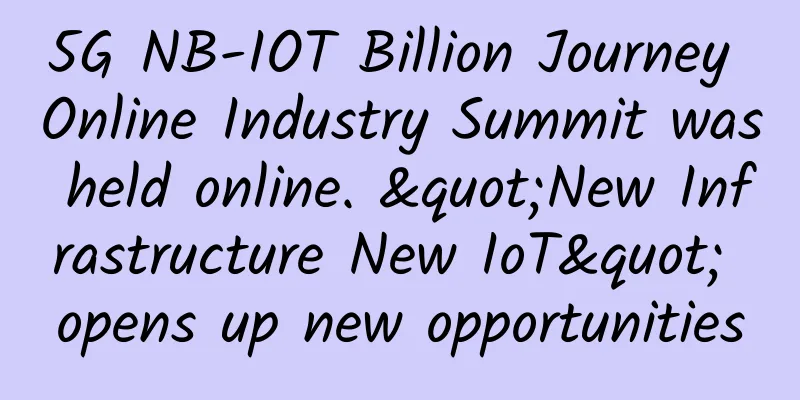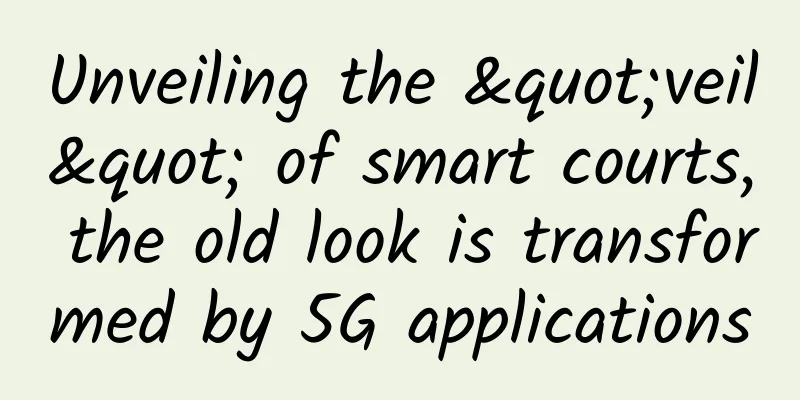5G NB-IOT Billion Journey Online Industry Summit was held online. "New Infrastructure New IoT" opens up new opportunities

|
[51CTO.com original article] On April 15, 2020, the 5G NB-IOT Billion Journey Online Industry Summit with the theme of "New Infrastructure New IoT" was held online as scheduled. Liu Yulin, Deputy Director of the Information and Communications Development Department of the Ministry of Industry and Information Technology, Cao Ming, Vice President of Huawei's Wireless Product Line, Zhang Yang, Deputy Director of the Wireless Application and Industry Research Department of the China Academy of Information and Communications Technology, and Yang Hua, Secretary General of the TD Industry Alliance, and other important guests were invited to give keynote speeches. More than 6,000 netizens watched the most abundant NB-IoT industry feast at the beginning of 2020 online.
Three suggestions to calmly embrace new opportunities in the Internet of Things Liu Yulin, deputy director of the Information and Communications Development Department of the Ministry of Industry and Information Technology, revealed in his speech that by the end of last year, my country had built more than 700,000 NB-IoT base stations, achieving continuous coverage of major cities and townships across the country, laying a good network foundation for the development of various applications. Today, the number of mobile Internet of Things connections in the entire network exceeds 1 billion, of which NB-IoT has exceeded 100 million after three years of development. The number of connections for typical applications such as smart water meters, smart gas meters, smoke sensors, and electric vehicle monitoring has reached millions, or even more than 10 million. New large-scale applications such as smart street lights, smart parking, and smart door locks continue to emerge. The novel coronavirus outbreak this year has had a significant impact on all walks of life and the lives of people across the country. The control requirements to reduce interpersonal contact have also enabled the Internet of Things to show its capabilities. A series of products such as non-contact long-distance thermometers, patrol drones, epidemic prevention robots, and isolation area induction door magnets have been widely used in epidemic prevention and control and resumption of work and production. Liu Yulin pointed out that although the development of mobile Internet of Things represented by NB-IoT has achieved breakthrough results, it also faces some challenges: First, NB-IoT applications need to be further popularized. At present, most of my country's NB-IoT connections are concentrated in a few cities, and the degree of universality across the country is still lacking. A large number of base stations are in a light-load or no-load state. Second, although the general utilization efficiency of 2G and 3G technologies is low, they account for nearly 20% of the new Internet of Things connections. It is also necessary to accelerate the formation of a development pattern in which NB-IoT, 4G, and 5G technologies are gradually taking over various types of Internet of Things connections. Third, NB-IoT network coverage needs to be further improved. The NB-IoT network coverage level in some areas cannot fully meet the requirements of carrying 2G connection migration, but the local coverage depth needs to be strengthened. Faced with this situation, Liu Yulin made several suggestions for the development of the mobile Internet of Things industry: First, accelerate the construction of 5G networks and coordinate and improve the network coverage of NB-IoT. He believes that the network is the foundation for the development of the Internet of Things. Basic telecommunications companies should accelerate the deployment of 5G networks, aiming at SA independent networking, accelerate the construction of networks in major cities, and extend coverage to key counties and towns with conditions, laying a good foundation for the development of mobile Internet of Things. In response to the needs of important application scenarios, further improve and optimize the quality of NB-IoT networks, strengthen deep coverage, and strongly support the continued development of various applications. Secondly, we should strengthen the construction of IoT management platforms and open up their capabilities. The connection management platforms of telecommunications companies should be connected to the application management platforms of vertical industries on the basis of continuous improvement and development. In particular, the management platforms of operators should open up interfaces and capabilities to industry application platforms to help industry customers manage their services more flexibly and conveniently and maximize the value brought by NB-IoT networks. Finally, give full play to the supporting role of industrial alliances and public service platforms, create a good industrial development environment, carry out mobile Internet of Things development monitoring, promote and guide NB-IoT applications and industrial development in various places, encourage capable large enterprises and units to build open laboratories, provide research and development, testing, verification, etc. for small and medium-sized enterprises, and give birth to more new Internet of Things applications, new models, and new formats. Establish a mobile Internet of Things resource library, organize excellent application case collection activities, and increase promotion and publicity efforts. The momentum of the spark has set off, and we expect explosive growth in 2020 Cao Ming, vice president of Huawei's wireless product line, said in his speech that the NB-IoT industry has made rapid progress in the industry, ecology, standards, and policies. In January this year, the number of global connections exceeded 100 million, and in February, the number of Chinese connections exceeded 100 million, which marked that the NB-IoT industry has passed the historical turning point and entered a stage of explosive growth. It is expected that by the end of the year, the number of global 5G NB-IoT connections will double again. In terms of industry, domestic traditional industries continue to develop rapidly, with the number of smart water and smart gas connections steadily moving towards 20 million, and starting to develop in depth from meter reading to network management and monitoring. Emerging applications of 5G NB-IoT are also emerging in an endless stream, such as door magnets, infrared temperature measurement, in-vehicle financial risk control, gas alarms, and charging sockets. In terms of ecology, with the explosive growth of industry applications, the demand for 5GNB-IoT chips is becoming increasingly strong. More and more companies are joining the chip ecosystem. Domestic companies such as Yixin and CoreWing have recently been selected for the operator's centralized procurement list. Zhilian's NB-IoT products have passed the operator's inventory test. Many start-ups such as chip semiconductors are also accelerating the process of large-scale commercialization. In terms of standards, the 5GN B-IoT protocol is constantly evolving and its capabilities are constantly being enhanced. Based on the R14 version, the NB-IoT uplink rate can reach 154KBPS, the downlink rate can reach 100KBPS, and the mobility can reach 80km/h; the R15 and R16 versions introduced functions such as small packet fast transmission and ultra-low power paging to further reduce latency and power consumption, and integrated 5G into the architecture, supporting the 5G new air interface, access to the 5G core network and slicing functions, making it part of the 5G Internet of Things technology. In terms of policy, the Internet of Things has risen to the level of social infrastructure. At the Central Economic Work Conference, the Chinese government defined 5G, artificial intelligence, industrial Internet, and the Internet of Things as new infrastructure construction, and clearly stated that it would accelerate the construction of emerging infrastructure such as 5G networks and data centers, providing a solid foundation for the industry's digital transformation and economic and social development. In terms of global applications, NB-IoT's industrial applications have spread like wildfire. Germany, Sweden, Belgium, Italy, South Africa, the United Arab Emirates, Thailand, Australia, South Korea, Japan, Brazil and many other countries have already commercialized NB-IoT services on a large scale, including more than 200,000 bicycles in Belgium, more than 100,000 charging piles in South Korea, 1 million gas meters in Italy by the end of the year, and 5 million electric meters being tendered in Saudi Arabia and Sweden. China's industrial partners have seized the opportunity and successfully entered the overseas market with the help of their industrial advantages. Domestic NB-IoT module manufacturers have supplied more than 6 million pieces to overseas markets, and electric meter manufacturers have won more than 2 million NB-IoT electric meters in the Middle East. NB-IoT: The industry is booming, and we are witnessing the journey to the billion-level Yang Tao, Vice President of Huawei's China Carrier Business Department, gave a more detailed introduction to the future development of NB-IoT and the many scenarios that Huawei is creating with the ecosystem. He said that Huawei will continue to enable the intelligence of new services through NB-IoT in the future. He gave an example that in the past, in smart home scenarios, although the WiFi installation rate was high, the utilization rate was low, because once the network connected to the terminal, the recovery operation was complicated and the customer experience was poor. However, NB-IoT is completely different. It provides cloud repair and maintenance through operators, which greatly reduces the threshold for consumers to use it and greatly increases the connection rate, thereby promoting the development of smart homes. Not only that, NB-IoT can also be used in smart factories, consumer electronics, and logistics tracking. Huawei and the 5G Internet of Things Alliance have jointly released 100 NB-IoT application scenarios, including shared economy emergency management and smart cities, to create new infrastructure in this field. "When Huawei tried NB-IoT street lights, the value was limited due to the small number of accesses. Now Huawei has introduced multi-carriers, which have increased the concurrent carrying capacity by 2-8 times. In addition, the coverage capability has been enhanced and the QS differentiation part is expanding. It is still NB-IoT street lights, but it can achieve more and richer application scenarios." According to Yang Tao, Huawei will continue to invest in chip networks and platforms, and will smoothly evolve to 5G in the next step. On the one hand, it will promote the evolution of standards and equipment, and on the other hand, it will increase chip investment, continue to iterate, and launch cost-effective chips. He introduced that compared with the previous generation, the number of Huawei's NB-IoT devices has been reduced by 50%, the power consumption in typical scenarios has been reduced by 50%, and it is also equipped with an independent security CPU and hardware security mechanism, which greatly improves the integration. "In the platform part, Huawei will realize cloud migration, and in the infrastructure part, it will enable better IoT connections through collaboration, realizing star-cloud collaboration, edge-cloud collaboration, and cloud-network collaboration; the other part will provide stable, reliable, secure, and low-cost IoT software services." Yang Tao emphasized that Huawei will continue to enable ecological partners and provide partners with integrated listing, deployment, integration, and operation and maintenance based on Huawei Cloud through the IoT service platform, and quickly develop hardware for standard IoT models. Cao Ming emphasized that Huawei will, as always, promote and follow the evolution of the protocol, vigorously carry out solution innovation, and build end-to-end competitiveness together with industry and production partners. He believes that with the dual support of new infrastructure closely linked to the development of high-tech and the new Internet of Things characterized by 5G, 5G NB-IoT will further ride the wind and waves and accelerate its progress. Let us work together to participate in and witness the 5G NB-IoT industry's billion-dollar journey. [51CTO original article, please indicate the original author and source as 51CTO.com when reprinting on partner sites] |
<<: What does a 5G base station look like? What is the difference between it and 4G?
>>: Another "explosive" application in the 5G era, what is the future of cloud gaming?
Recommend
China Mobile plans to jointly purchase 700MHz base stations with China Radio and Television this year
China Mobile recently released its annual perform...
ExtraVM: $5.5/month KVM-1GB/12G NVMe/1TB/Japan Data Center
ExtraVM is a foreign hosting company founded in 2...
Migrate to the cloud safely? See how Neusoft Cloud Start (NCSS) does it
Today, the development of cloud computing has rea...
Two ways of TCP retransmission
There is no communication without errors. This se...
802.11ax emerges, what does it bring to wireless?
In 2017, Broadcom, Qualcomm, Marvell and other ma...
SDN/NFV/CLOUD is too complex and AI and 5G accelerate the reconstruction of the network
Just like decoration in life, during the decorati...
Comparative analysis of five smart home wireless technologies: KNX RF, Zigbee, Z-Wave, WiFi, BLE-MESH
Smart home solutions need to comprehensively cons...
Huawei Cloud 12.12 Membership Festival invites you to join the carnival. In the 5G era, Huawei Cloud is the right choice!
[51CTO.com original article] Guess what the first...
Why 99% of business leaders are paying attention to this issue
Digitalization and the provision of digital servi...
Megalayer: US CN2 line VPS annual payment 159 yuan, Hong Kong VPS annual payment from 199 yuan
Megalayer is a hosting provider founded in 2019 a...
Feiyuxing Wireless helps the famous Yueyang No. 16 Middle School realize campus informatization construction
The 16th Middle School of Yueyang City, Hunan Pro...
Huawei's new generation of 400GE data center switches enable new infrastructure and stimulate new momentum
[[334907]] Hu Kewen, President of Huawei's Da...
HostYun: Australian VPS starting from 23 yuan per month, AMD5950X+M.2 SSD+remote backup
HostYun provides VPS and independent server renta...
Will broadband market operators monopolize the market? Private capital faces difficulties
On November 26, 2014, the Ministry of Industry an...
Microsoft redesigns the calling interface in Teams
[[356857]] Microsoft Corp. has reportedly begun r...









